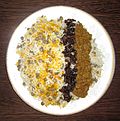Lentil rice
Lentil Rice, also known as Mujaddara or Mujadara in some regions, is a traditional dish found in the cuisines of the Middle East and parts of the Mediterranean. It is a simple yet nutritious meal that combines lentils and rice, often seasoned with onions that are either fried or caramelized, and a variety of spices. This dish is known for its affordability, ease of preparation, and high nutritional value, making it a staple food in many households.
Ingredients and Preparation
The basic ingredients of Lentil Rice include:
- Lentils: Brown, green, or black lentils are commonly used. They are a great source of protein, fiber, and minerals.
- Rice: Long-grain rice, such as Basmati or Jasmine, is preferred for its fluffy texture and ability to absorb flavors.
- Onions: Typically sliced and caramelized to a deep brown color, adding a sweet and savory flavor to the dish.
- Spices: Common spices include cumin, coriander, cinnamon, and allspice. The choice of spices can vary based on regional or personal preferences.
The preparation of Lentil Rice involves cooking the lentils and rice either separately or together, depending on the recipe. The onions are usually caramelized in oil or butter until they are deeply browned and then mixed into the cooked lentils and rice. The dish can be served hot or at room temperature, often garnished with additional fried onions or fresh herbs like parsley.
Cultural Significance
Lentil Rice has a rich history and is deeply embedded in the culinary traditions of many countries, including Lebanon, Syria, Jordan, and Egypt. It is often associated with humility and simplicity, due to its origins as a meal for the poor. However, its delicious taste and nutritional benefits have made it a beloved dish among people of all social classes.
In some cultures, Lentil Rice is consumed during times of fasting or religious observance, such as Lent in the Christian tradition, where meat is often abstained from. It symbolizes sustenance and sustenance without luxury.
Nutritional Value
Lentil Rice is a highly nutritious meal, providing a balanced combination of carbohydrates, protein, and fiber. Lentils are an excellent source of plant-based protein and are rich in iron, folate, and magnesium. Rice provides energy through carbohydrates, and the onions add vitamins and antioxidants. When prepared with minimal oil, Lentil Rice can be a low-fat, healthful option suitable for various diets.
Variations
There are numerous regional variations of Lentil Rice, each adding its unique twist to the basic recipe. Some versions include the addition of vegetables like tomatoes or spinach, while others incorporate different grains such as bulgur or quinoa instead of rice. Spices and garnishes can also vary widely, reflecting local tastes and culinary traditions.
Serving Suggestions
Lentil Rice can be served as a main dish or as a side. It pairs well with a variety of accompaniments, such as yogurt, salad, or pickles. In some regions, it is common to serve it with a side of meat, such as grilled chicken or lamb, making it a more substantial meal.
Lentil_rice
Transform your life with W8MD's budget GLP-1 injections from $125.
W8MD offers a medical weight loss program to lose weight in Philadelphia. Our physician-supervised medical weight loss provides:
- Most insurances accepted or discounted self-pay rates. We will obtain insurance prior authorizations if needed.
- Generic GLP1 weight loss injections from $125 for the starting dose.
- Also offer prescription weight loss medications including Phentermine, Qsymia, Diethylpropion, Contrave etc.
NYC weight loss doctor appointments
Start your NYC weight loss journey today at our NYC medical weight loss and Philadelphia medical weight loss clinics.
- Call 718-946-5500 to lose weight in NYC or for medical weight loss in Philadelphia 215-676-2334.
- Tags:NYC medical weight loss, Philadelphia lose weight Zepbound NYC, Budget GLP1 weight loss injections, Wegovy Philadelphia, Wegovy NYC, Philadelphia medical weight loss, Brookly weight loss and Wegovy NYC
|
WikiMD's Wellness Encyclopedia |
| Let Food Be Thy Medicine Medicine Thy Food - Hippocrates |
Medical Disclaimer: WikiMD is not a substitute for professional medical advice. The information on WikiMD is provided as an information resource only, may be incorrect, outdated or misleading, and is not to be used or relied on for any diagnostic or treatment purposes. Please consult your health care provider before making any healthcare decisions or for guidance about a specific medical condition. WikiMD expressly disclaims responsibility, and shall have no liability, for any damages, loss, injury, or liability whatsoever suffered as a result of your reliance on the information contained in this site. By visiting this site you agree to the foregoing terms and conditions, which may from time to time be changed or supplemented by WikiMD. If you do not agree to the foregoing terms and conditions, you should not enter or use this site. See full disclaimer.
Credits:Most images are courtesy of Wikimedia commons, and templates, categories Wikipedia, licensed under CC BY SA or similar.
Contributors: Prab R. Tumpati, MD


